You might not at first connect Paris with medieval times, or the so-called Dark Ages. Paris is the City of Light, after all. Of enlightenment. The city that came of age in the grand siècle — the seventeenth century — when grand new buildings and monuments were carved from bright limestone, when the Sun King set the streets a-glitter with lighting that dazzled the world.
Then came Baron Haussmann, in the mid-nineteenth century, the city prefect with a disdain for old-fashioned half-timbered buildings and higgledy-piggledy streets, and a mania for wide, grand boulevards that sliced through Paris in unrelentingly straight lines. Haussmann had no time for nostalgia, even less for the Middle Ages.
Fortunately, Haussmann didn’t have the chance to eradicate every trace of the city’s medieval past. There are still many ways to appreciate, and step back into, this mysterious era of Parisian history.

The most obvious, and magnificent, monument of medieval times is, of course, the Cathédrale Notre-Dame de Paris. Its first stone was laid in 1163, when Paris was flickering into glamorous life, a precursor to its future as the City of Light. Historians talk about the ‘Twelfth-Century Renaissance,’ a time that saw Paris, and much of Europe, develop artistically and culturally. For most of the twelfth century, regional peace allowed Paris to ease up on its defences, looking within its walls instead of just outwardly, and spend money on beautifying the growing metropolis. Building a monumental cathedral that would give the city international gravitas was key to the grand Parisian vision.
Look up at the façade. You can well appreciate how the cathedral would have energised the city’s artistic scene: the architects, builders, masons, sculptors, glassmakers … a new generation of proud Parisian aesthetes.
Seeing as Notre-Dame is closed for renovations after that devastating fire (it’s due to reopen in time for the 2024 Olympics), make your way to Sainte-Chapelle for a lesson in medieval splendour.
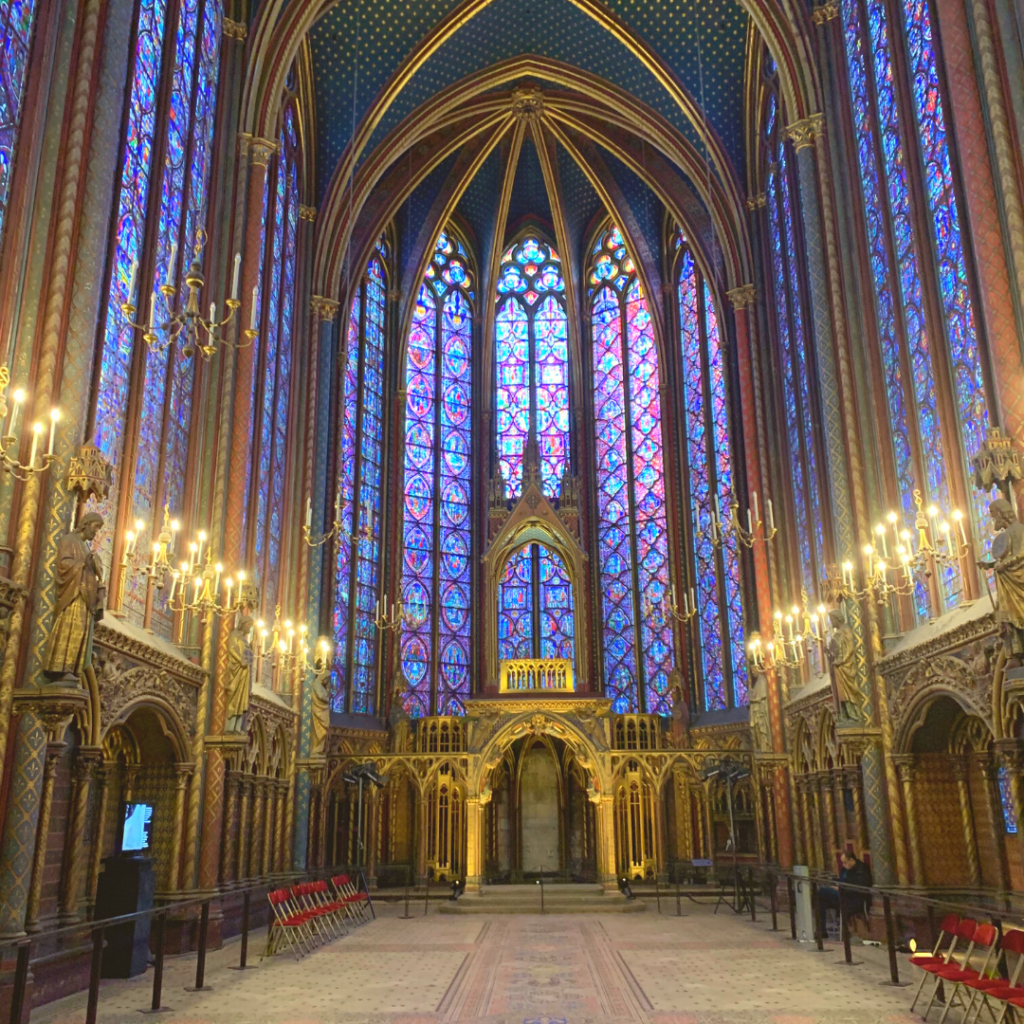
First, you enter the lower chapel, a vaulted crypt sumptuously painted polychromatically, in red, blue and gold. That’s gorgeous enough, but from here to the upper chapel is like night to day, earth to heaven. The glittering stained-glass windows seem to soar to celestial heights, to a vaulted ceiling bedazzled with gilded stars, and the rose window, with its intricate tracery and psychedelic petals, is absolutely mesmerising. Dating from the mid-thirteenth century, this style of architecture is called Rayonnant — radiant — for the glorious glasswork techniques. When the sun is shining, its rays shoot through the biblical tales of the glazing, falling onto the floor as gem-like shards. If you get the feeling you’re in a jewel box, there’s a reason for that: King Louis IX built the chapel primarily as a reliquary for the purported crown of thorns.
It was during one of his two crusades that the king acquired the precious relics, but the crusades brought so much more back to Europe. Architectural inspiration, for one. The graceful, pointed arches and dramatic ribbed vault ceilings that became mainstays of medieval style, for example, were inspired by the Arab world, in the cultural awakening that came to Europe after the First Crusade of 1095. Unlike the West, the East had not forgotten about the texts of Ancient Greece and Rome, and it was the retranslation of books on science, philosophy and mathematics from Arabic back to Latin that ignited the twelfth-century Renaissance, inspiring architects, artists and artisans.
By the way, this architectural genre was originally named Gothic as a slur, in the Renaissance era when the rediscovery of Classical art made the creations of the Middle Ages seemed a little crude; the Goths were one of the barbaric tribes that had attacked Western Europe as the Roman Empire waned. But as Sainte-Chapelle well proves, medieval architecture could be a thing of marvel.
Sainte-Chapelle was the jewel of the old Palais de la Cité, the seat of the monarchy until the Louvre took over that honour, and the sprawling site of city administration until Haussmann and his bulldozing ways came along.
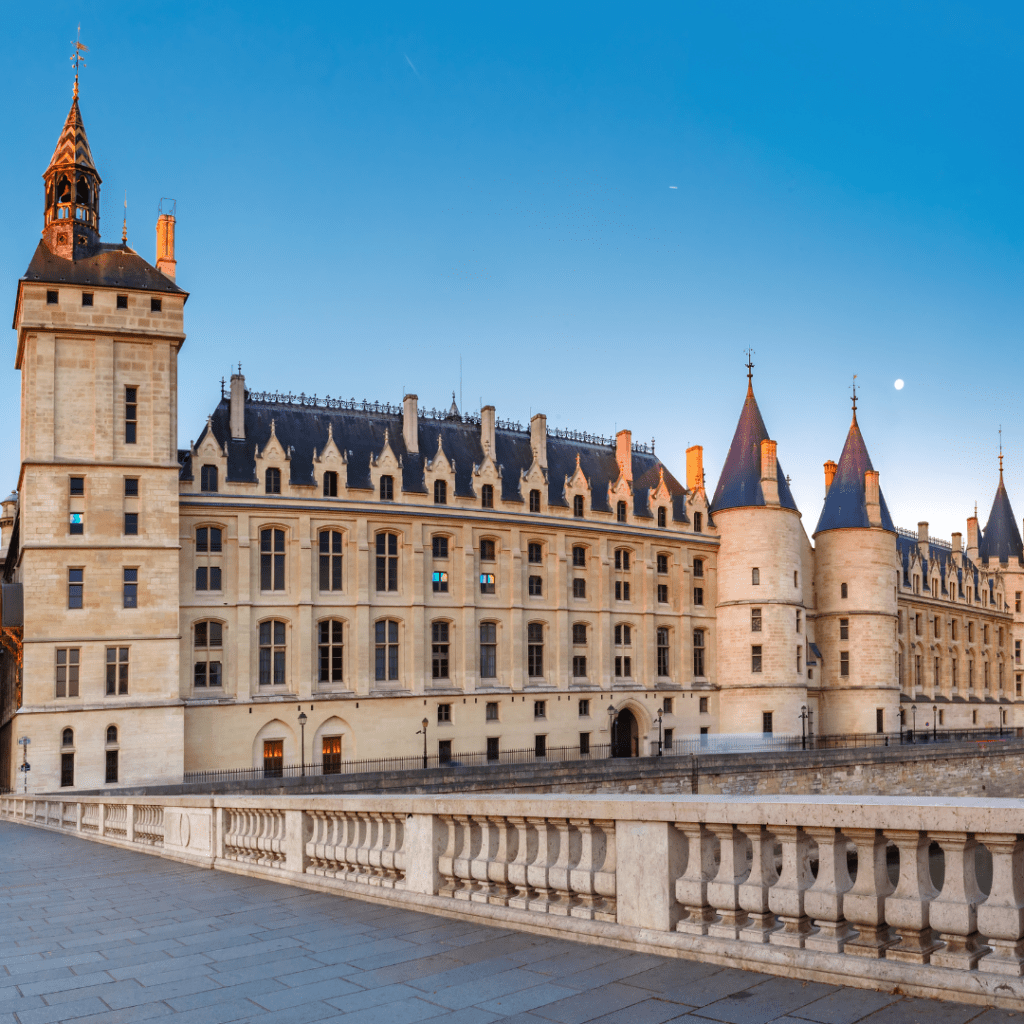
A surviving remnant is the Conciergerie, a little north of Sainte-Chapelle, in the turreted building on the northern edge of the island (above). It’s most notorious as the place of Marie-Antoinette’s final prison, but its story goes much further back in time. The first space you step into is the Salle des Gens d’Armes from 1302, the old soldiers’ room and the largest medieval hall in Europe, with its echoing arches pointing upwards to dramatically lit ribbed-vault ceilings. A ‘HistoPad’ lets you digitally travel back to its early glory days of banquet tables and roaring fires, and a glimpse into the old kitchen is especially fascinating. But despite this virtual visit back to the Middle Ages, it’s impossible to forget that the Conciergerie became an infamous jail. A sense of gloom seems to hang in the air, especially in the Salle des Gardes, where in 1793 Robespierre set up his fearsome Revolutionary Tribunal, and in the old prison wing, which is sure to give you chills.
In medieval times, some fifteen thousand Parisians called the Île de la Cité home. Short of googling old photographs by Eugène Atget and Charles Marville, Rue Chanoinesse (a couple of blocks east of the Conciergerie) will give you the best sense of the old island streets.
At the western end of Rue Chanoinesse (Canoness St) there was once one of four gates that allowed entry into the Cloître de Notre-Dame, which for many centuries covered the north-eastern corner of the island. Not a cloister so much as a city within a city, it was the cathedral town that housed those Parisians connected with the operations of the church, such as canons.
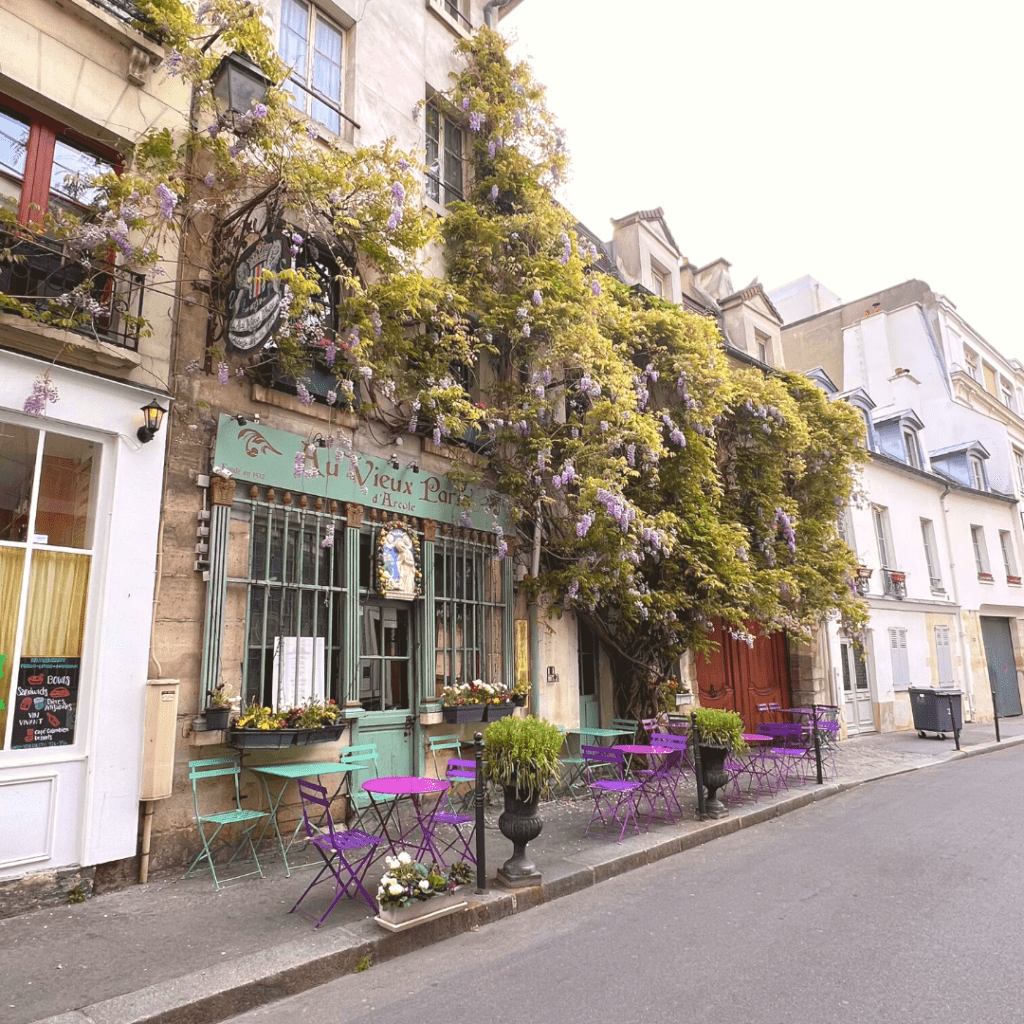
Many canons lived on Rue Chanoinesse, as the name suggests. One of the oldest of such houses, dating from 1512, is now a restaurant called Au Vieux Paris (above). Stop here for lunch — either outside by the beautiful (hopefully blooming) wisteria-laden façade, or in the fabulous interior, which is reminiscent of a wanton medieval boudoir, all red velvet and crystal goblets. It’s a delightful, not to mention delicious, way to travel back through time.

Walk next up the Rue de la Colombe — named for the sculpted doves above the harlequin-window-topped doorway at no.4 — and at the gorgeous olde-worlde wine bistrot turn right into Rue des Ursins (above), a road that teasingly suggests a stroll back into history. It ends where another cloister gate once stood, and just next to where the famous medieval lovers, Héloïse and Abelard, began their steamy affair in the early twelfth century, in the home of Héloïse’s Uncle Fulbert, a Notre-Dame canon (a plaque at 9-11 Quai aux Fleurs marks the spot).
A little east is a bridge that takes you to Île Saint-Louis. For now, ignore this island — a post-medieval seventeenth-century creation, with its shimmering limestone and straight streets — and keep walking towards the Marais, a quartier left alone by Haussmann (not by choice: he was forced from his job in 1870, and from completing his vision for a new Paris). That means the Marais is a more layered district than most, and its medieval history features in its millefeuille of an architectural mix.

Continue walking over Pont Louis-Philippe onto Rue du Pont Louis-Philippe. Turn right at Rue François Miron. On your left you’ll soon see two tall and skinny old half-timbered houses (above). Many ancient Parisian buildings would look similar beneath their outer plaster, which was layered on during the seventeenth century to give the impression of stone, considered a more noble material — and one that was safer, after the Great London Fire of 1666. Note the pitched gable roofs — a sure sign of a medieval design, dated to a time before neat, straight lines and tidy mansard roofs became the norm.
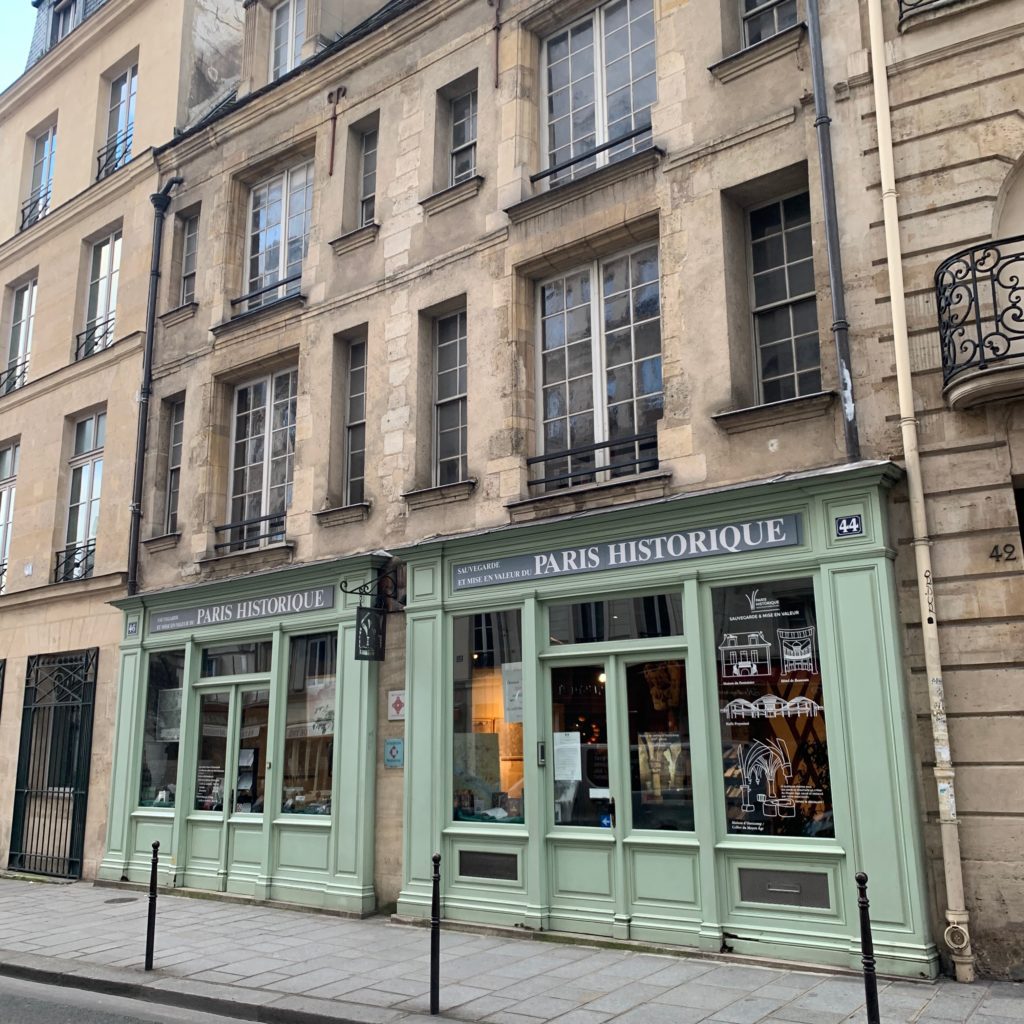
On the opposite side of the street is Paris Historique, the association for the appreciation and conservation of old Paris. Here you’ll find a great selection of books and old maps that make wonderful souvenirs.
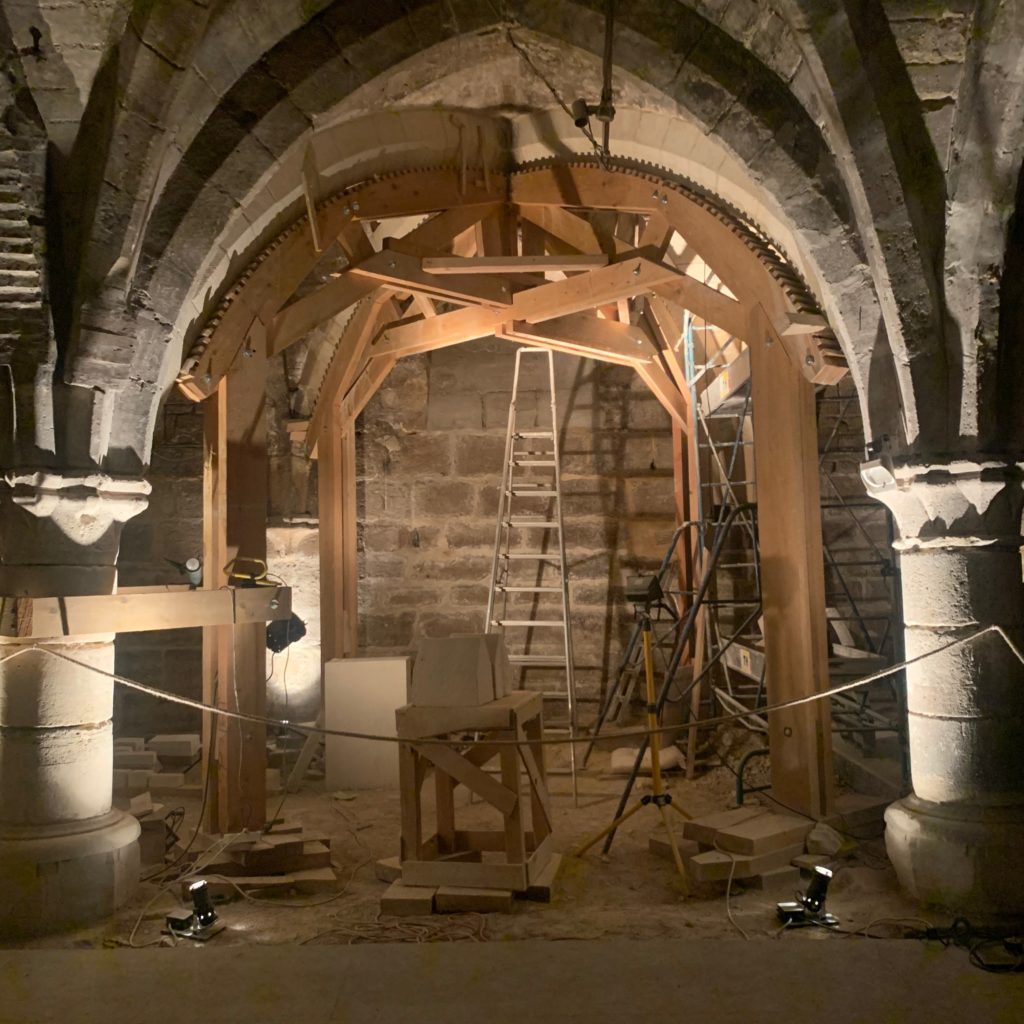
Appropriately, the business sits atop the cellar of a thirteenth-century townhouse; you can tour the cellar for a few Euros — it goes towards the renovation, which is in process, using medieval construction methods (above).
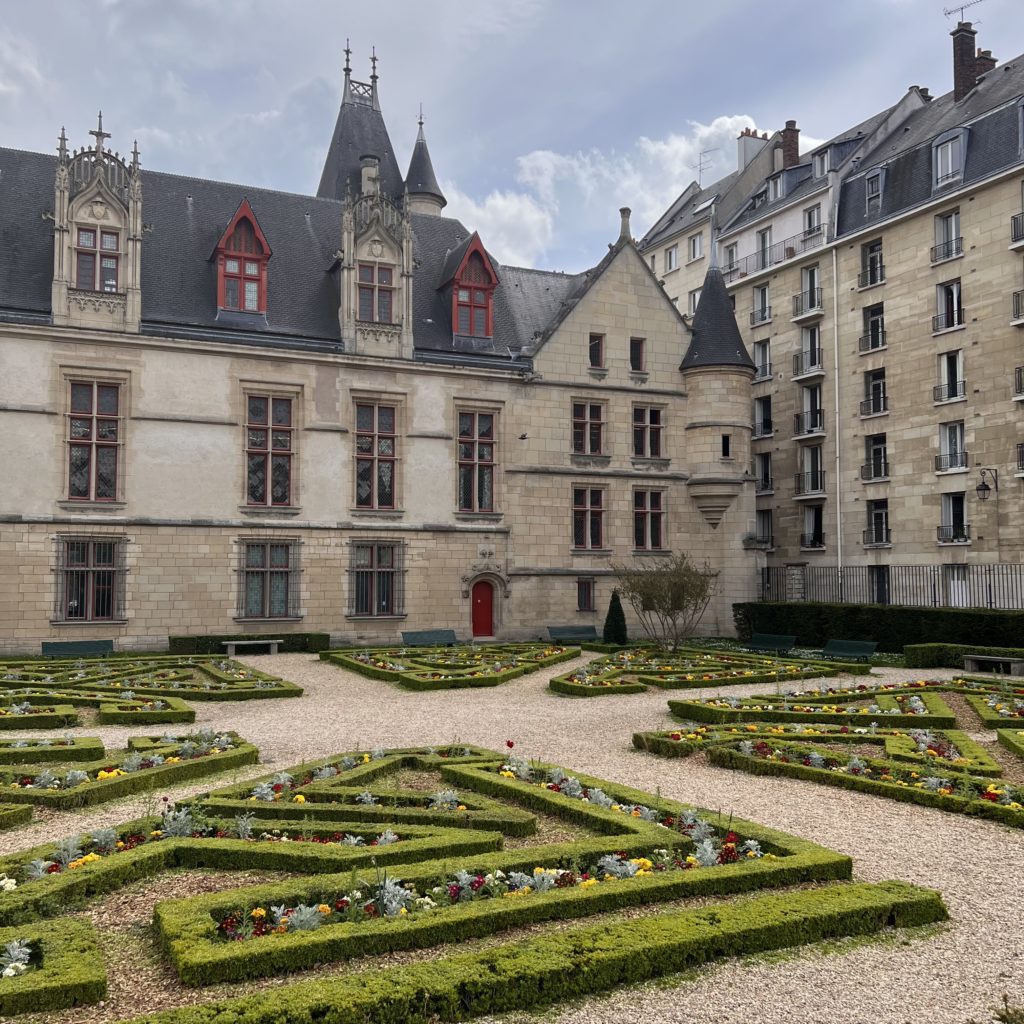
Back outside, keep walking eastwards before veering right at Rue de Jouy, then turning right again onto Rue des Nonnains d’Hyères. On your left you’ll soon come to a parterre garden set before what appears to be a medieval palace, a fantasia of turrets and mullioned windows (above). The Hôtel de Sens — originally home to the archbishops of Sens when in town — dates from around 1500, making it one of the oldest buildings in Paris.

Head around to the front entrance; the Hôtel de Sens is now the Bibliothèque Forney, a library devoted to the creative arts. If the library is open (Tuesday, Friday, Saturday, 1pm-7:30pm; Thursday, 10am-7:30pm), you’ll be able to snoop around the courtyard. Most of the old hôtel is, admittedly, a reconstruction, but the arched doorways and elaborately framed windows are wonderfully evocative nevertheless.
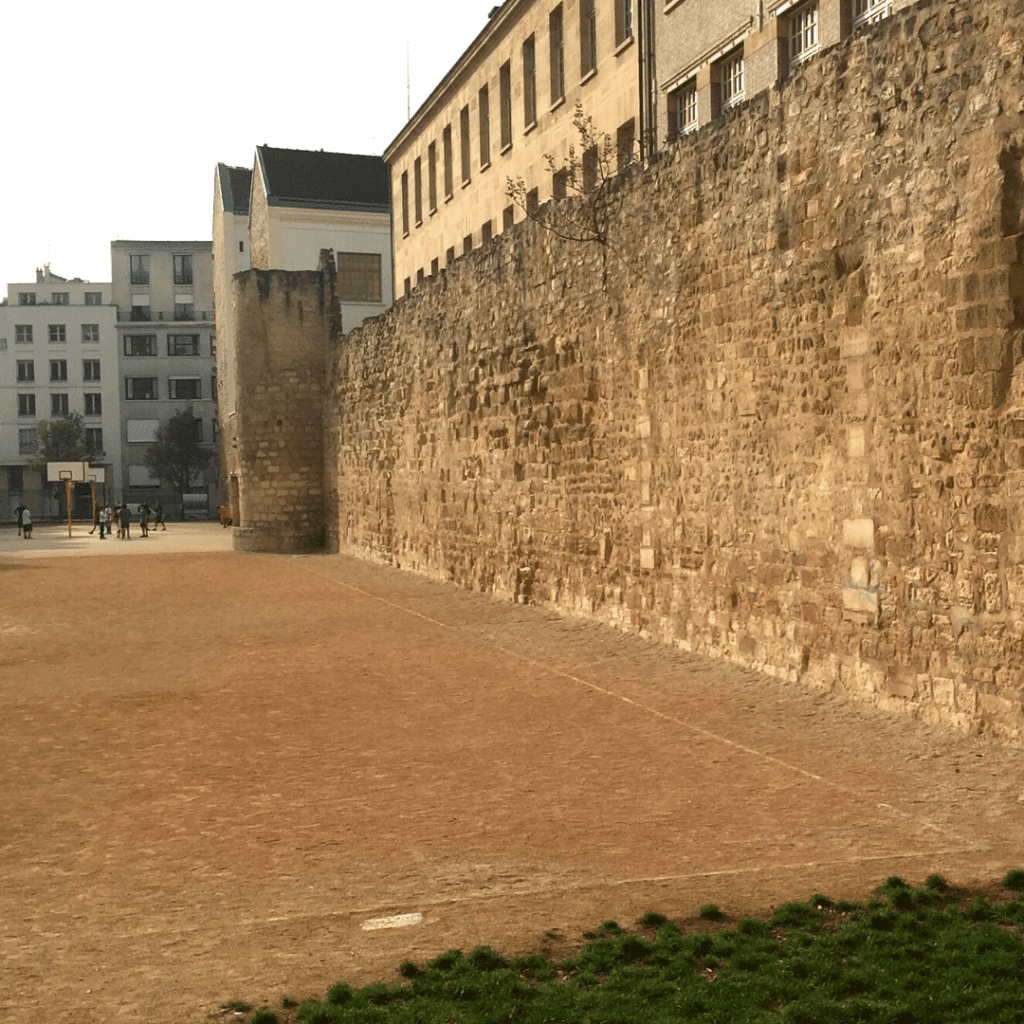
A little further east, along Rue de l’Ave Maria, you’ll come to a basketball court on your left. Turn north at Rue des Jardins Saint-Paul. As you walk the length of this sporting field you’ll see it’s edged by an old wall (above).

This is not just any wall, mind you, but remnants of the thirteenth-century city wall, which was (mostly) knocked down when the city wall was pushed further outwards in the fourteenth century, opening up acres of lush ground — marshland (marais) that had been drained — that was just begging to be lavished in grand houses.
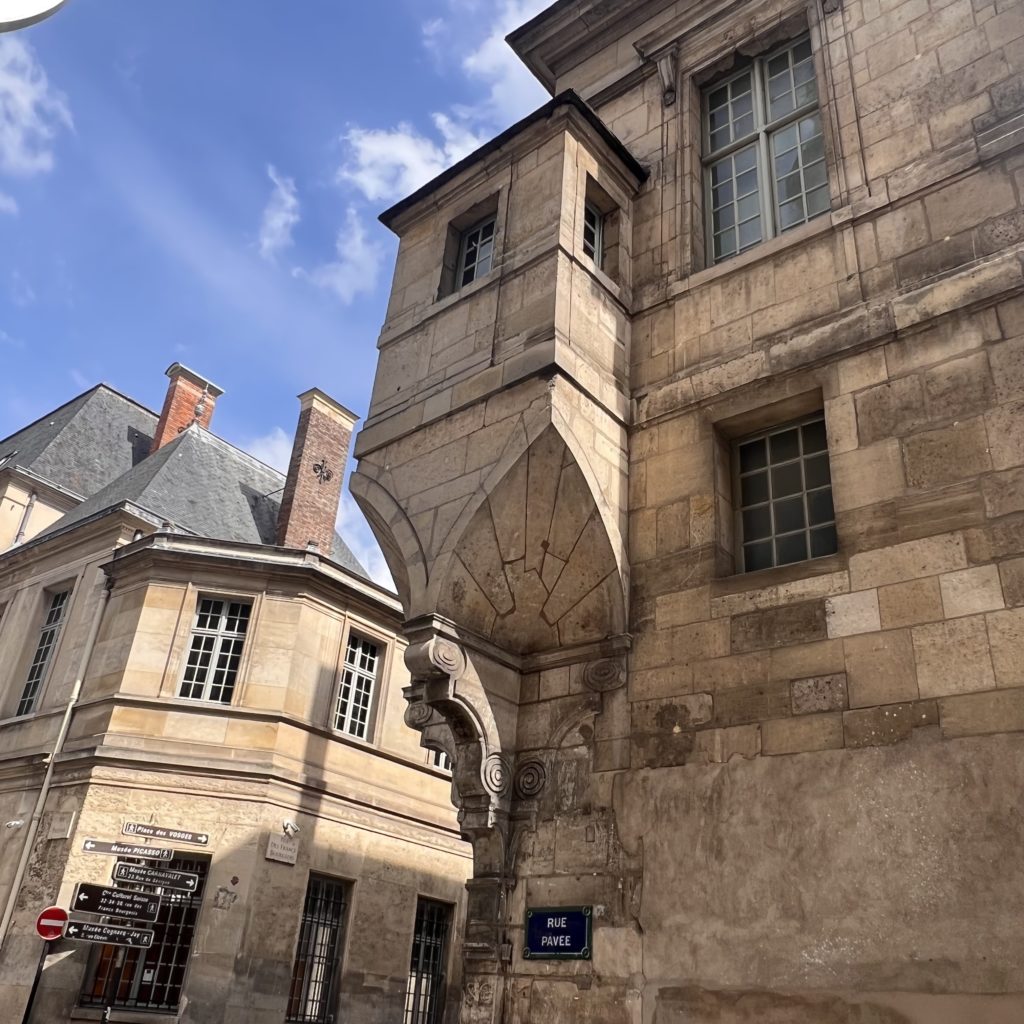
As you wander around the streets of the Marais, such as the Rue des Francs-Bourgeois, you’ll see the occasional sign of the district’s medieval past, in the form of corner turrets or old watchtowers (such as that pictured above), but most Gothic architecture was knocked down to make way for Renaissance townhouses, known as hôtels particuliers.
One of these, the Hôtel Carnavalet, is now the Musée Carnavalet. This fabulously rambling, rabbit’s hole of a museum, which now links several old townhouses, showcases the history of Paris.
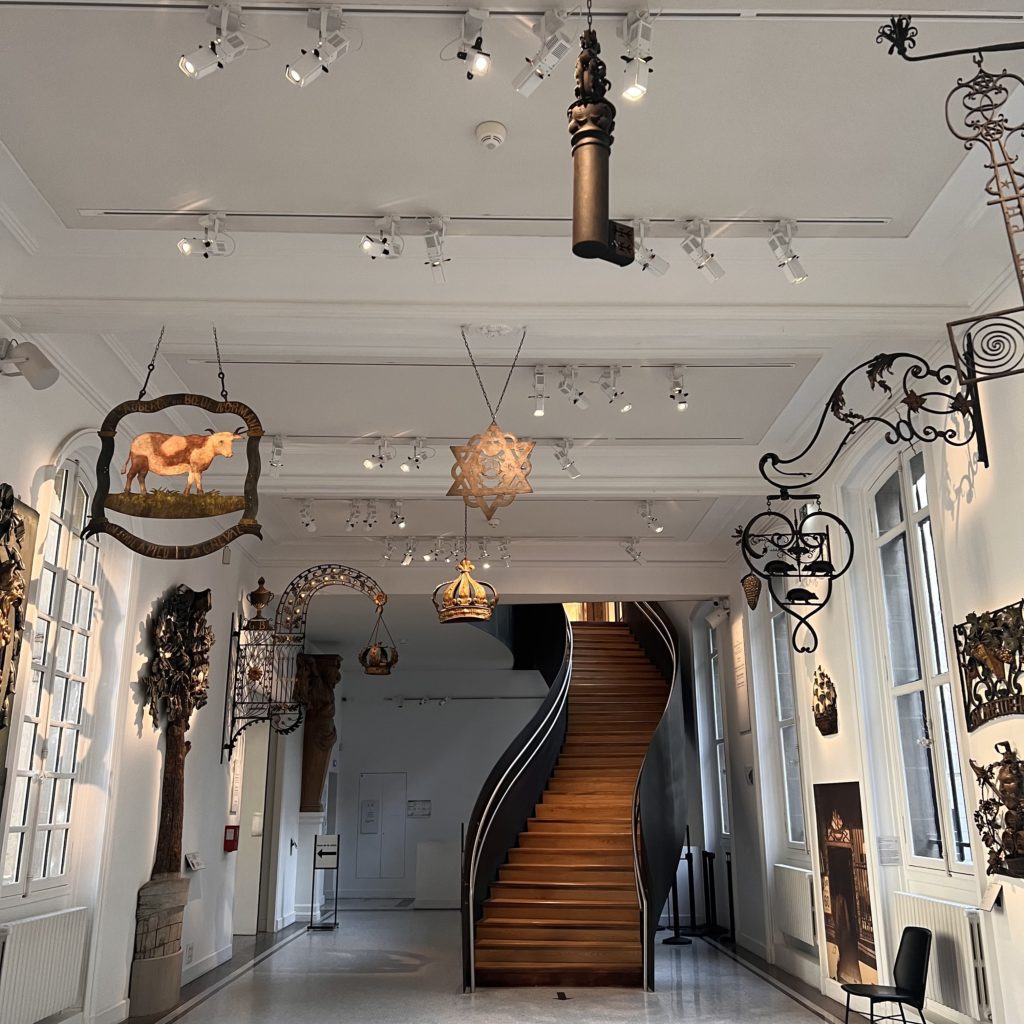
The Middle Ages are represented in the stunning gallery of old shop signs (above), as well as in a wing within the vaulted basement.
Speaking of museums, all lovers of old Paris should set aside a few hours for the recently reopened and renovated Musée de Cluny, over in the Latin Quarter.

The National Museum of the Middle Ages is set within the turreted townhouse originally known as the Hôtel de Cluny. Built towards the end of the fifteenth century, it’s suitably flamboyantly Gothic in style, with mullioned windows, glowering gargoyles and sculpted scallop shells. (This shell was the symbol of Saint Jacques, the patron saint of crusaders, and often featured on a house to indicate that the owner had made the pilgrimage to Santiago de Compostela).
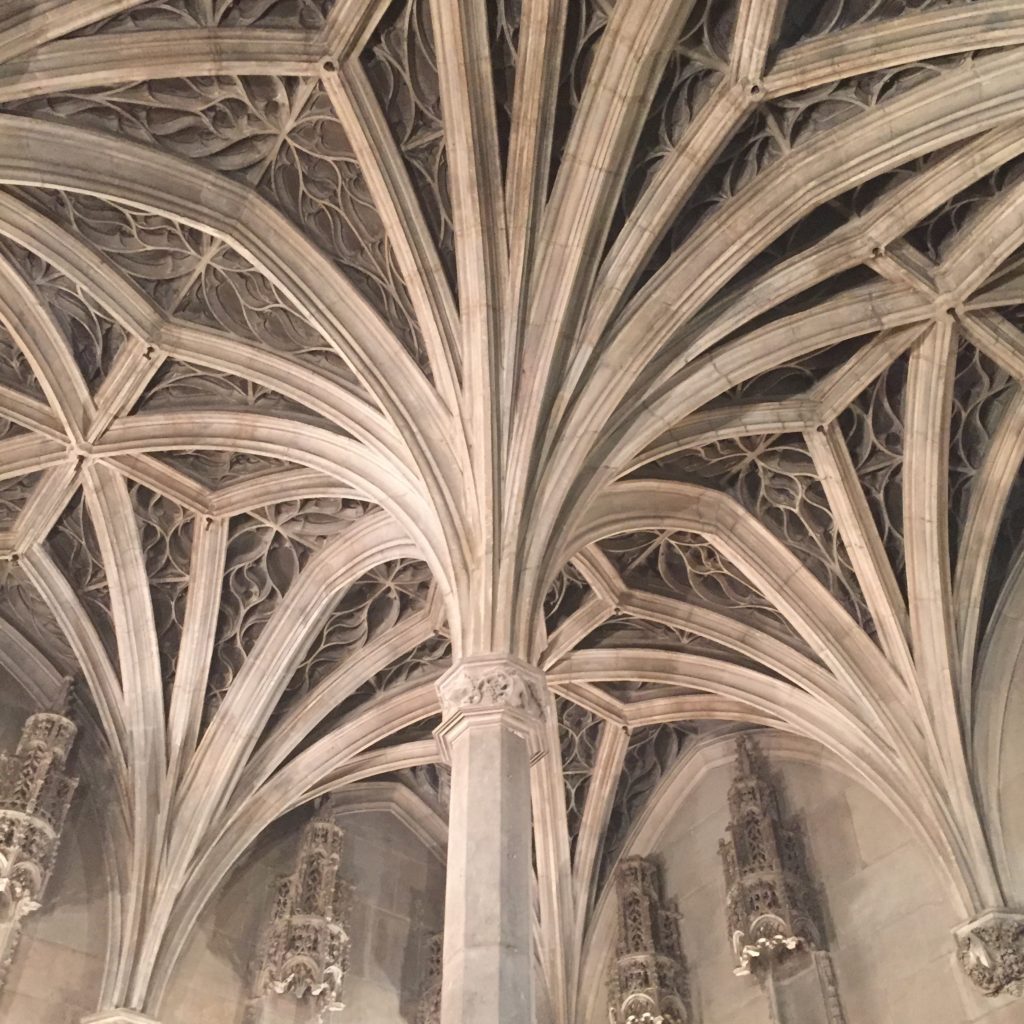
Inside the museum, beneath the wood-beamed ceilings and fantastical vaults that seem to have been spun into webs of lace filigree by some magical medieval creature (above), are sculptures with faces so gorgeous as to have been touched by an angel, exquisitely gemmed jewellery as glossy as bonbons, and stained glass panes and religious paintings that pop with vibrantly alive blues and reds. A sprig of roses, from 1330, has been delicately nurtured from gold; an ivory mirror case etched with the forlorn figures of Tristan and Isolde makes your heart melt; and exotically carved hair combs and perfume vials look nothing short of miniature works of art. For anyone still under the impression that medieval times were really those Dark Ages, a visit to the Cluny is a revelation.
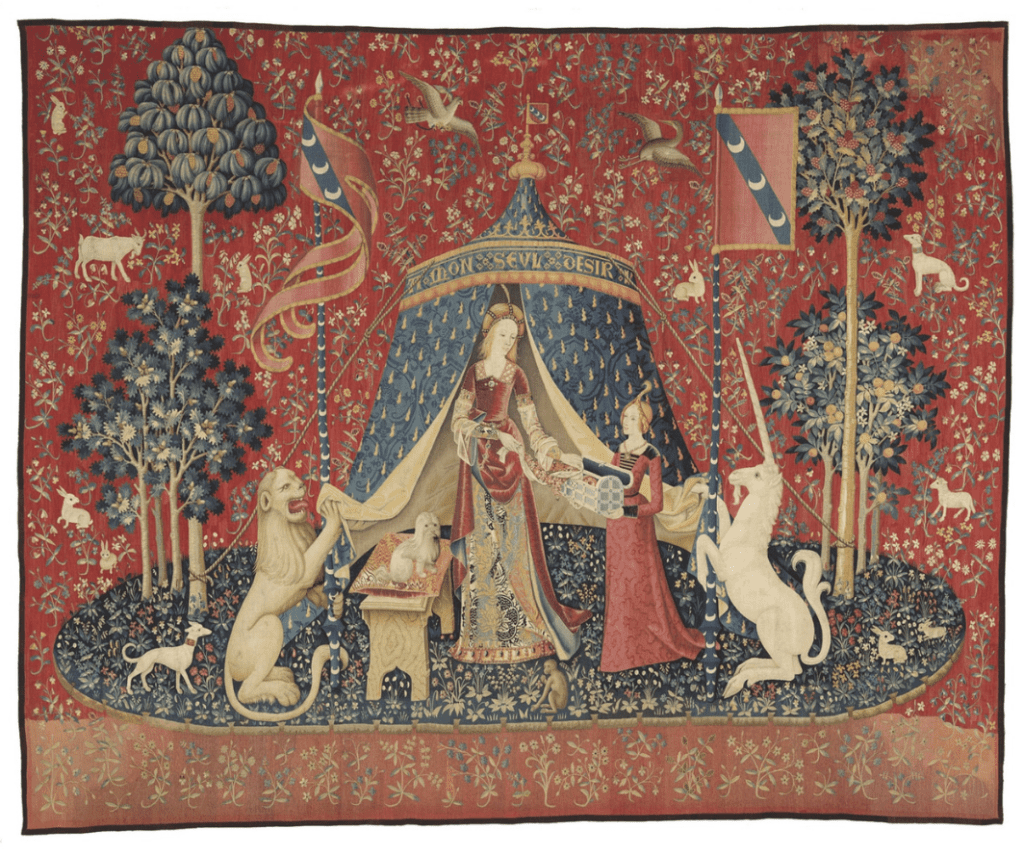
And then there’s the star of the show, The Lady and the Unicorn, the series of wool and silk tapestries featuring an opulently dressed, glamorously tressed maiden and her loyal, loving white unicorn, who exist on an enchanted island amid all sorts of flora and fauna. Five of the weavings represent the senses, and the sixth labelled My Sole Desire (above); you can’t help but see the Middle Ages through a new lens. Not a dark and gloomy one, but a more rose-tinted variety, one that celebrated beauty and love.
Just as the Renaissance did afterwards, and Roman times beforehand. The Hôtel de Cluny, incidentally, was built on the site of the old Roman baths, remnants of which remain as part of the immersive museum experience. Bathe in the beauty of the former frigidarium, or cold room; the multi-coloured marbles, mosaics and frescoes depicting scenes of the good Roman life have long gone, but the stony splendour of the vaulted ceilings, which soar to fourteen metres in height, are awe-inspiring.
History always surprises, especially so in Paris, a city that becomes more multi-dimensional the more you explore it. Despite Haussmann’s best efforts, you can find many portals into other eras, especially into the atmospheric medieval era. If you just know where to look.

